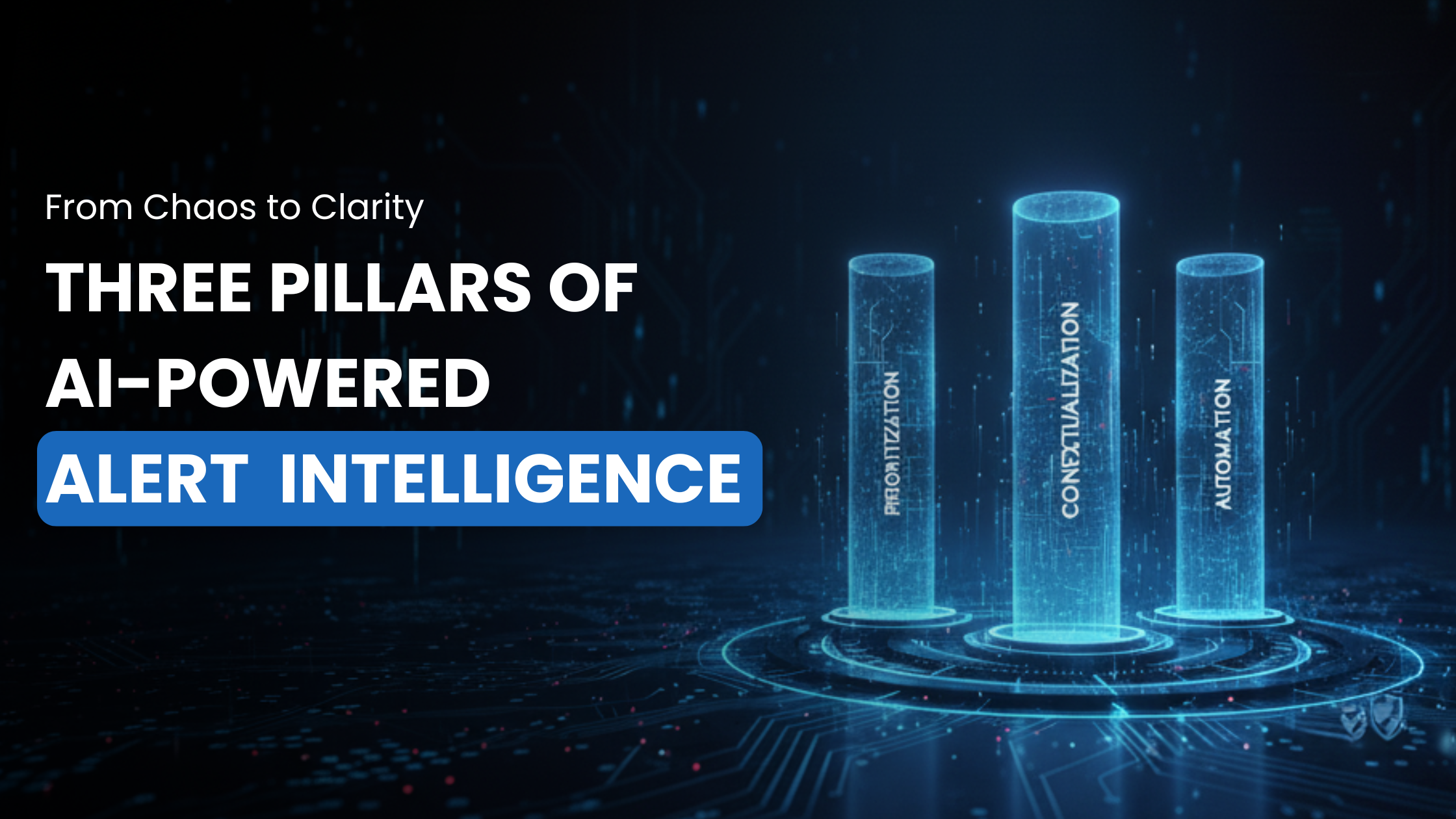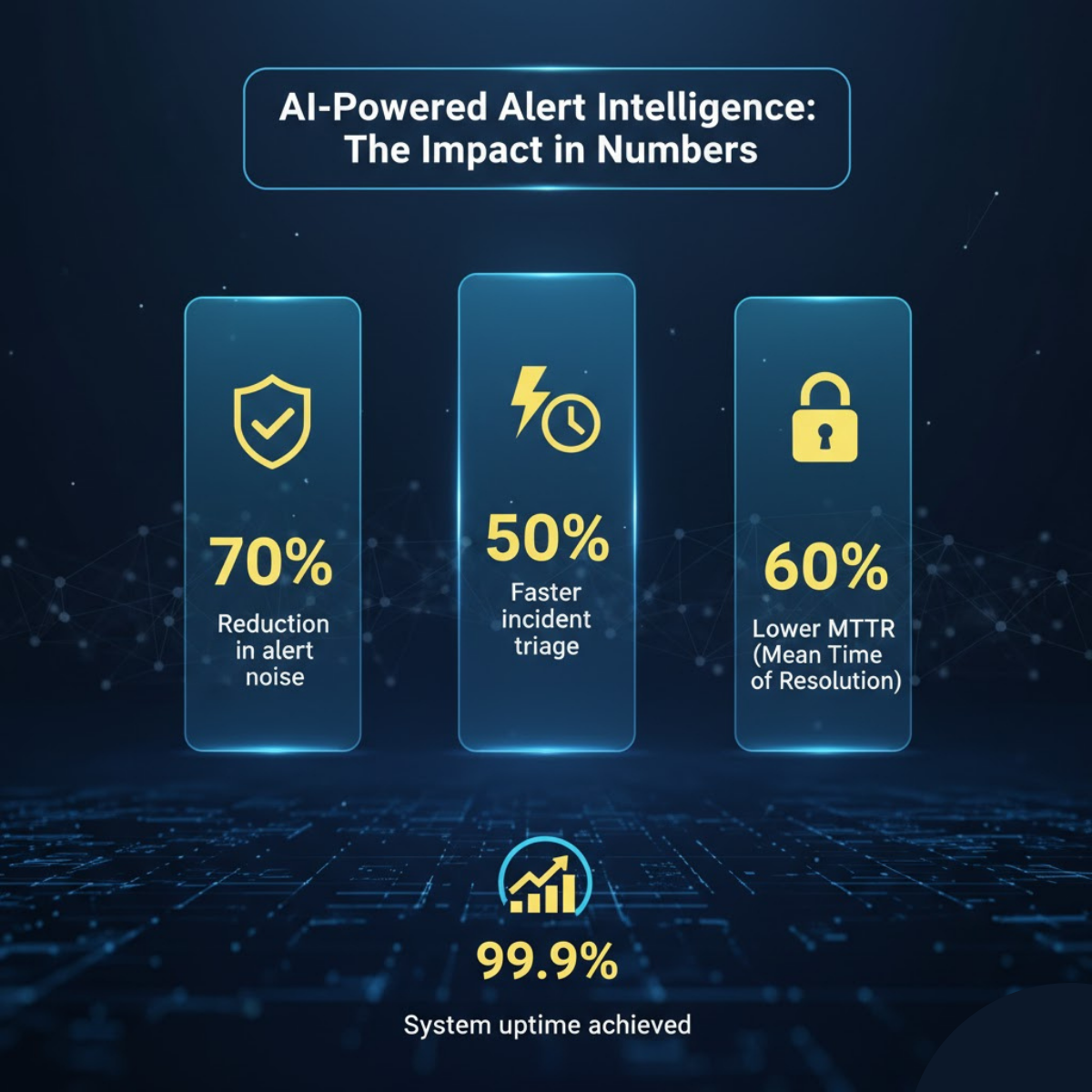How to Reduce Alert fatigue with AI-Powered Alert Intelligence
Cuts 85% of Alert Noise and Boosts Efficiency

Imagine this: It’s 2 a.m., your eCommerce platform suddenly slows down, and the incident dashboard explodes with hundreds of alerts, CPU spikes, failed API calls, delayed transactions.
Your on-call engineer rushes in, but by the time the root cause is found the database replication lag and customers have already abandoned their carts, and the business loses thousands.
This is the everyday chaos many IT, DevOps, and SRE teams face.
The problem isn’t just system failure, it’s alert fatigue. When teams get hundreds of alerts every hour, they lose focus on what truly matters.
That’s where AI-powered alert intelligence steps in, not just to detect issues, but to help teams see patterns, prioritize the right alerts, and act faster.
Learn more about alert fatigue and its impact
The Problem: Too Many Alerts, Too Little Context
Modern enterprises run complex architectures, hybrid clouds, microservices, containers, and distributed data systems. Each layer produces logs, metrics, and events.
While observability tools capture everything, they often create too much noise.
Here’s what typically happens:
- Teams get thousands of alerts daily and many redundant or false positives.
- Critical alerts are buried under low-priority notifications.
- Mean Time to Resolution (MTTR) increases.
- Engineers get desensitized and leading to slower incident response.
In fact, according to PagerDuty, over 60% of alerts in enterprise systems are non-actionable, and MTTR can exceed 4 hours in high-volume alert environments.
The Solution: AI-Powered Alert Intelligence
AI-powered alert intelligence transforms the way incidents are handled. Instead of flooding dashboards with noise, it filters, prioritizes, and contextualizes alerts to guide faster decisions.
Think of it as moving from “alert overload” to “actionable insight.”
Let’s break it down into three core pillars:
1.Contextual Correlation
AI systems analyze alerts across multiple data sources, logs, metrics, traces and connect related events automatically.
Instead of treating 50 similar alerts as separate issues, the AI groups them under one root cause, saving hours of manual investigation.
Example:
When a database slowdown triggers latency in APIs, the AI system correlates these alerts and identifies “database read latency” as the single cause preventing alert storms.
Benefit:
Reduces alert volume by up to 70%, freeing teams from noise and enabling faster triage.
2.Intelligent Prioritization
Not every alert deserves immediate action. AI models learn from historical patterns, which alerts led to downtime, which were ignored and use that context to rank new alerts by business impact.
Example:
If an alert affects a customer-facing service or payment gateway, the system automatically escalates it to high priority, while routine alerts are handled later or suppressed.
Benefit:
Cuts down unnecessary escalations and focuses attention on alerts that matter most, reducing MTTR by 40–60%.
3.Predictive Resolution
The final pillar is about moving from reactive firefighting to proactive prevention.
AI-powered systems can predict potential incidents based on anomaly detection, spotting trends like memory leaks or slow degradation before failure occurs.
Example:
By analyzing CPU spikes and error logs over time, the AI predicts that a particular microservice may crash in the next 30 minutes, triggering preventive action before downtime.
Benefit:
Helps achieve 99.9% uptime and drastically reduces customer-impacting incidents.
Use Cases Across Industries
AI-powered alert intelligence is not just for IT operations; it’s reshaping performance monitoring across industries.
1. E-Commerce
Detects cart abandonment or API failures in real time and alerts teams before sales are lost.
2. Manufacturing
Monitors IoT sensors, production lines, and predictive maintenance data, ensuring zero unplanned downtime.
3. Banking & Financial Services
Identifies anomalies in transaction processing or payment systems, reducing fraud risks and operational delays.
4. Healthcare
Ensures uptime of life-critical systems and reduces incident response time in hospital IT infrastructure.
5. Cloud & SaaS Providers
Monitors thousands of customer environments, automatically correlating alerts and reducing false alarms across multi-tenant architectures.

Real-World Example: From Chaos to Calm
A global retail company faced daily alert floods from over 30 microservices and 10 monitoring tools.
Engineers struggled to isolate real issues leading to average MTTR of 5 hours and frequent downtime.
After implementing AI-powered alert intelligence:
- Redundant alerts reduced by 68%.
- MTTR dropped to 1.8 hours.
- Customer satisfaction scores improved by 35%.
The transformation wasn’t just technical, it built confidence. Teams could finally trust their alert systems again.
Conclusion: From Firefighting to Forecasting
Enterprises can’t afford to let alert fatigue slow them down.
AI-powered alert intelligence is the bridge between data chaos and operational clarity.
By combining contextual correlation, intelligent prioritization, and predictive resolution, organizations can move from reactive monitoring to proactive resilience, where systems heal faster, teams act smarter, and customers stay happier.
FAQ's
- What is AI-powered alert intelligence?
Answer: AI-powered alert intelligence uses machine learning to filter, prioritize, and correlate alerts, reducing false positives and enabling faster incident response. - How does AI reduce alert noise?
Answer: By automatically grouping related alerts and learning from past incidents, AI can reduce redundant notifications by up to 70%, letting teams focus on what matters. - Can AI predict IT failures before they happen?
Answer: Yes, predictive resolution capabilities allow AI to detect anomalies and forecast potential failures, helping prevent downtime and maintain uptime of 99.9%. - Is AI alert intelligence applicable outside IT operations?
Answer: Absolutely. Industries like e-commerce, manufacturing, banking, healthcare, and SaaS leverage AI alert intelligence for proactive incident management and improved operational efficiency.

